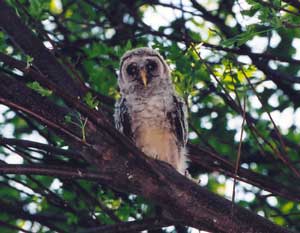









|
The Ecology of Barred Owls
|
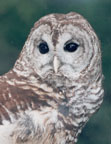 |
[The "Home" button on the menu along the left margin gets you back to OspreyTrax]
I left Charlotte and moved to Philadelphia in 2011, leaving Charlotte's Barred Owls are on their own again. No more free mice, fancy radios, and silver ankle bracelets.
I've just (Feb 2017) resurrected the Barred Owl section of my old UNC-Charlotte website. There are lots of loose ends and pages I never got around to finishing, but these pages will give a good flavor of what my four graduate and many undergratuates accomplished over a decade of studying the remarkable Barred Owls of Charlotte and the surrounding piedmont forests.
Contents of these pages:
Barred Owl Natural
History (Barred Owl Basics)
Field
Research -
An overview of our research in Charlotte-questions, methods, and results.
Notes from
the Field - We will post slightly edited selections from our field
notebooks here as the season progresses.
Videos - I have uploaded some videos to
YouTube. Details here.
Annual
Census - Who's nesting where this year-and links to previous years'
data.
Nest Locations
-
Maps of the nests in the south Charlotte
suburbs.
Radio tracking
-
Movement
of young leaving their nest areas. {under construction}
Dispersal
- See where the young tagged or banded
have settled after leaving their
nest areas. {under construction}
Nest boxes
- Of some 70 nest boxes, we usually have about 20 occupied. Link to details and
plans for boxes.
Orphans
- Radio tracking orphans released by Carolina
Raptor Center.
 |
According to the text books, Barred Owls are supposed to need large stands of old-growth forest to survive. Yet the species is abundant throughout the older suburban neighborhoods of many cities in the southeast. Intrigued by this apparent contradiction, we initiated a study of Barred Owls in the Charlotte region in the central Piedmont of North Carolina in 2001. One of our initial question, simply put, was whether the books were wrong or have the local Barred Owls simply neglected to read the books?
Over the subsequent 8 years three
graduate students, a small flock of undergrads, and I have studied Barred Owls in both suburban and rural
habitats around Charlotte. Besides figuring out what Barred Owls are doing in
this unusual habitat, we are comparing the natural history of the two
populations. Are the city birds reproducing as well as their country cousins?
Are territory sizes the same? How exactly do the two habitats compare
structurally? Do the city and country birds rely on the same prey species? How
far do the young travel when they leave their natal territories? |
Besides increasing our knowledge of the
ecology of the Barred Owl, particularly in suburban habitats,
our goals include
using the
owls as environmental monitors, student training, and increasing community
sensitivity and involvement in the environment in their own backyards.
The first phase of the research was a study by UNC-Charlotte graduate student, Eric Harrold, comparing the home range, prey habits, and habitat characteristics of Barred Owls living in suburban environments with birds living in forested habitats less modified by humans. Eric defended his thesis in April 2003.
Eric found, not surprisingly, that there are significant differences in the structure of the habitat and nest trees used by owls in our two study groups. He found that males use a larger home range than females who spend more time close to the nest and young, and that these territories are much smaller than in any other Barred Owl population studied to date. Read his thesis abstract.
|
We have data from over 80 different pairs of owls nesting in 122 nests. Because nests are so much easier to find in the city, most of our data are from suburban birds, but we have a decent sample from country owls. Jim Mason was the second M.Sc. student on the project. Jim compared the reproductive success of city and country birds as well as the distances their young moved after leaving home. He could not detect a statistically significant difference between the nesting success of city and country birds. On average, our owls lay 2.14 eggs, 77% of nesting attempts are successful, and an average of 1.3 young are produced for each nesting attempt. Jim also found that young country birds disperse farther than city birds, probably because they have to travel farther across non-forested agricultural land or housing developments to find suitable nesting habitat. Read Jim's thesis abstract. |
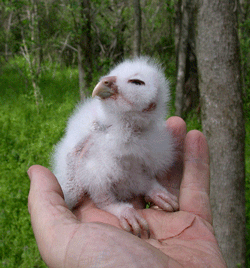 |
Cori Cauble, the third grad student on the project, used digital and analog video recordings from nests and nest boxes to compare the diets of city and country birds. After reviewing video taped records of over 1,500 prey deliveries to Barred Owl nests, Cori confirmed our initial impressions that city birds feed very heavily on birds--much more so than country birds and far more than in any other study of this species. Country owls deliver many more insects and reptiles and amphibians than do the city birds. Read Cori's thesis abstract.
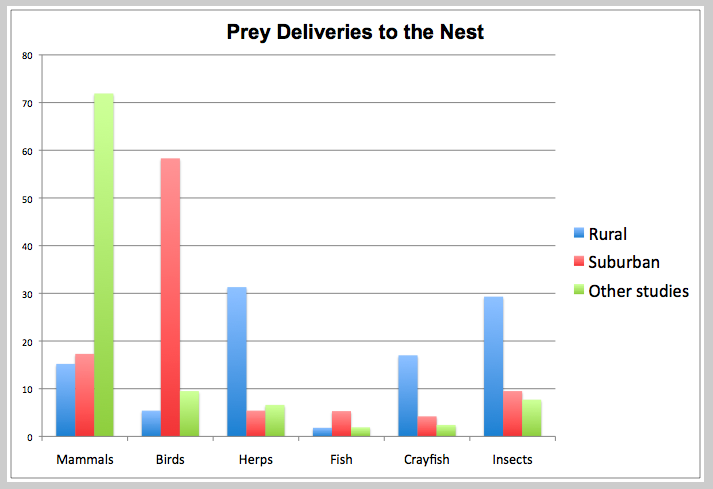
CONCLUSIONS
So, are the books wrong, or do Barred Owls just not pay attention to books? It turns out that, as far as the owls are concerned, the older suburban neighborhoods are in fact even more old-growth than real old-growth forest. Barred Owls like old-growth forests because they have trees big enough to have nest cavities that Barred Owls can use and an open understory, which fits their sit-and-wait hunting technique perfectly. Suburban neighborhoods provide plenty of big trees with cavities, as well as chimneys (and, in Charlotte, at least, plenty of nest boxes), and a very open understory--mown lawns with gardens and azalea bushes. The preponderance of birds in the diet of city owls may be the result of both abundant bird feeders and this very open understory, which may make it harder for small birds to find a safe place to sleep.
Barred Owls are thriving in the city. While they do suffer a relatively high rate of fatal encounters with cars, territorial vacancies are generally filled within a matter of weeks.
Extrapolating from the density of owls in our best-studied areas of 2 pairs per square mile, it is safe to predict that there are at least 300 pairs of Barred Owls within 10 miles of downtown Charlotte.
As our studies continue, we will continue to collect data from both city and country nests, focusing on the country population, where our database is weakest. We're always interested in new pairs and welcome leads to new nests. We will continue banding and telemetry studies to document the dynamics of both populations.
This research is funded by the Impact Fund of the Foundation for the Carolinas, UNC-Charlotte's Biology Department, the Carolina Bird Club, and anonymous donations.
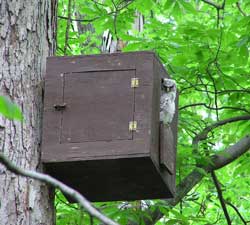 |
Part of this long-term research effort entails
establishing a population of owls in nest boxes that are easily accessible
to our researchers. We have already placed about 50 boxes in suitable
habitat. In 2008, 19 boxes were in use.
(This box is larger than our current version, which has a 19" x 19" floor plan.) |
We hope to continue to expand the number of boxes in our study area. If you have a box already on your property or would like to build, or buy one, please contact us via email (rbierreg@uncc.edu - just click to send a message).
Barred Owls will use nest boxes, but putting
one up is no guarantee that it will be used, as we've discovered. Boxes should
be up by mid September. If they're put up much later, the birds may have already
made their housing decision for the upcoming breeding season.
(Although in 2009 we had a pair totally surprise me, setting a new record by
occupying a box a month after we put it up on 1 February!)
Boxes should be 15-20' off the ground. Click the link
below to see the design we've come up with after several years of experimenting.
We will provide and install a box in return for a $150 contribution to the
Barred Owl project. If you'd like to build the box yourself, click the link
below for plans. If you build and install a box yourself, we'd appreciate
knowing where the box is and monitoring it if owls use it.
Click here to see the "Definitive" Barred Owl Nest Box plan.
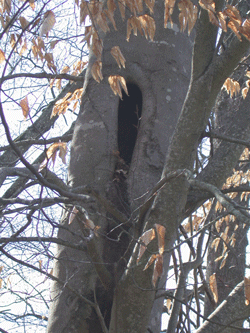 |
Barred owls usually nest in a hole in a big tree. The holes can be of all sorts. Often the nest will be in a broken hollow trunk, which we call chimney nests. (And they will use real chimneys, which just look like brick trees to an owl.) More often in the city, where we don't let hollow, dead trees stand around very long, the nests will be in a hollow tree with the birds entering through a hole in the side of the tree. Often they will find a cavity where a branch has broken off the side of a tree, leaving an uncovered cavity. Quite rarely, they will use an abandoned hawk or crow nest. (Great-horned Owls do this much more commonly.) |
Through determined field work, the help of
radio telemetry, and a little bit of good luck, we have located nests in rural
areas (Latta Plantation and Reedy Creek Nature Preserves, and rural Harrisburg),
and in trees, chimneys, and nest boxes in suburban Charlotte.
In 2004, we followed 45 nesting pairs. 11 of these were in rural forests and parks, with the rest mostly in the south Charlotte
suburbs. Click here to see a map
of the nests in the south Charlotte suburbs.
If you know of a nest anywhere in the Charlotte area, we
would like to include it in our study. This means we would take some
measurements of the nest tree and, if possible, count eggs and band young in the
spring. [Send an
email if you know of a nest that doesn't appear to be on our map.]
The picture below are of typical rural nest
trees, which are very often dead. Suburban nests are almost always in live
trees.
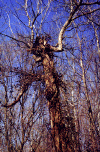 |
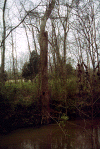 |
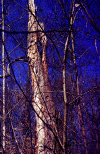 |
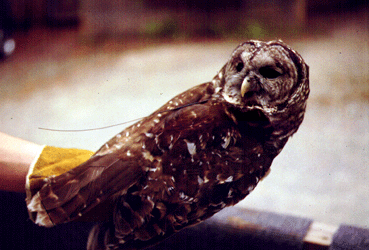
Most of our work is based on capturing adult or young owls and outfitting them with small radio transmitters. The transmitters are attached like a little backpack with the antenna extending down the birds back, as can be seen in the picture above).
Radio Telemetry-Orphans
Way back in 2000, we performed a pilot radio-telemetry study tracking owls that
made it through our rehabilitation
process. This project was undertaken in part to learn about following owls
with telemetry, but also to begin to collect some data on the fate of
birds that pass through a raptor rehabilitation program.
In 2001 we followed three orphans after their release from
Carolina Raptor Center.
The first bird was killed by a Great-horned Owl about a
week after it was released. We collected that bird's transmitter from a
pile of feathers and redeployed it on our next release.
The other two birds we followed were also graduates of "Mouse School" at CRC. This
means that they were young birds brought into CRC in the spring because,
for one reason or another, we could not reunite them with their parents.
Once they were full grown they spent a week or so in a large flight pen
catching live mice. Having demonstrated their proficiency at this all
important task, they were ready for release into the wild
 |
The first bird, nicknamed "Natalia," (although we later learned it was a male) fell out of its nest at the Nature Museum in Freedom Park in the spring of 2001. It was released on 25 July, after a broken wing healed. ( In this picture, you can see the radio antenna coming off the bird's back.) |
We followed as it wandered through south Charlotte and finally settled in to a neighborhood east of South Blvd, near the Arrowood intersection. In February, it had a run-in with a car and spent a few more days at CRC's rehab center before being released into the wild (again!).
The other bird was killed by a car a couple of months after being released.
In 2004, we radio tagged 5 orphans released in rural habitats around Carolina Raptor Center (3 birds) and Davidson College (2 birds).
See more details on the orphan tracking project.
Radio Telemetry-Adult Home Ranges & Dispersing Young
| We have trapped and
outfitted over 30 adult Barred Owls with small (10 g) radio transmitters,
mounted back-pack style with smooth teflon ribbon. A couple of birds
decided they didn't want to be part of the study and somehow got the
radios off, while the majority seem to not even notice their
high-tech accoutrement. We are now following these birds to learn
how big a territory they need and what sorts of habitat they prefer
to hunt in. We have analyzed and mapped 40-50 locations for nine adult Barred Owls in the south Charlotte suburbs in 2001-2002. Click here to see a map of adult territories. These studies continue as we look at how territories change over different breeding seasons and see how similar territories will be when one of a pair dies and is replaced. |
|
|
YOUNG
One of the important
questions we hope to answer with this research is whether owls in the
city/suburban habitat are as successful as their country cousins. To do
this, we need to follow young and see how long they survive after leaving
their nest areas. |
|
| In the spring of 2002, we placed radios on two
young, one from the Princeton pair near Freedom Park, and one from
the Colville pair in Eastover. In 2003 we tagged eight young,
and we are currently (2004) following 11 birds as they wander around Charlotte looking for a place to settle
down. See details of this research. |
||
Barred Owls in the News
On Jan. 6th, WJZY aired a Charlotte Now program wherein I talked about our on-going studies of Barred Owls in Charlotte. Link here to watch the show (it's about 30 minutes).
The Lehrer News Hour recently broadcast a segment on Spotted Owls. Barred Owls play a role in the seemingly never-ending plight of the endangered Northern Spotted Owl. Link here to watch the segment. Be forewarned that if you have blood pressure issues you may want to take some valium before watching a Bush-appointee refusing to answer a question from a U.S. Representative about their plans for the owl, which, as is par for the course, ignore all the science that has been published on the issue.
![]()
